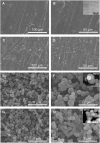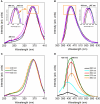Novel Highly Luminescent Amine-Functionalized Bridged Silsesquioxanes
- PMID: 29379781
- PMCID: PMC5775297
- DOI: 10.3389/fchem.2017.00131
Novel Highly Luminescent Amine-Functionalized Bridged Silsesquioxanes
Abstract
Amine-functionalized bridged silsesquioxanes (BSs) were synthesized from bis[(3-trimethoxysilyl)propyl] amine via a solvent-mediated route. BS-1 and BS-2 were obtained at neutral pH with sub- and stoichiometric amounts of water, respectively, and high tetrahydrofuran content. BS-3 was prepared with hyperstoichiometric water concentration, high tetrahydrofuran content, and hydrochloric acid. BS-4 was synthesized with hyperstoichiometric water concentration, high ethanol content, and sodium hydroxide. BS-1 and BS-2 were produced as transparent films, whereas BS-3 and BS-4 formed white powders. Face-to-face stacking of flat or folded lamellae yielded quasi-hydrophobic platelets with emission quantum yields of 0.05 ± 0.01 (BS-1 and BS-2) or superhydrophilic onion-like nanoparticles with exciting emission quantum yields of 0.38 ± 0.03 (BS-3) and 0.33 ± 0.04 (BS-4), respectively. The latter two values are the largest ever reported for amine-functionalized siloxane-based hybrids lacking aromatic groups. Fast Grotthus proton hopping between = [Formula: see text]/ = NH groups (BS-3) and = N-/ = NH groups (BS-4), promoted by H+ and OH- ions, respectively, and aided by short amine-amine contacts provided by the onion-like morphology, account for this unique optical behavior.
Keywords: bis[(3-trimethoxysilyl)propyl]amine; luminescence; morphology; sol-gel chemistry; solvent-assisted structuring.
Figures









References
-
- Assink R. A., Kay B. D. (1988). Sol-gel kinetics I. Functional group kinetics. J. Non Cryst. Solids 99, 359–370. 10.1016/0022-3093(88)90441-3 - DOI
LinkOut - more resources
Full Text Sources
Other Literature Sources
Miscellaneous

